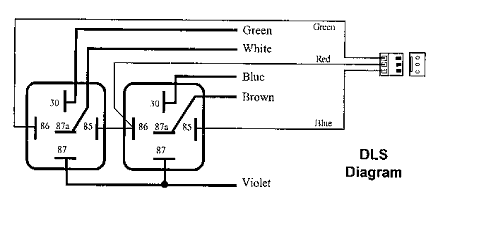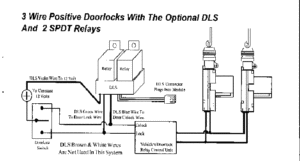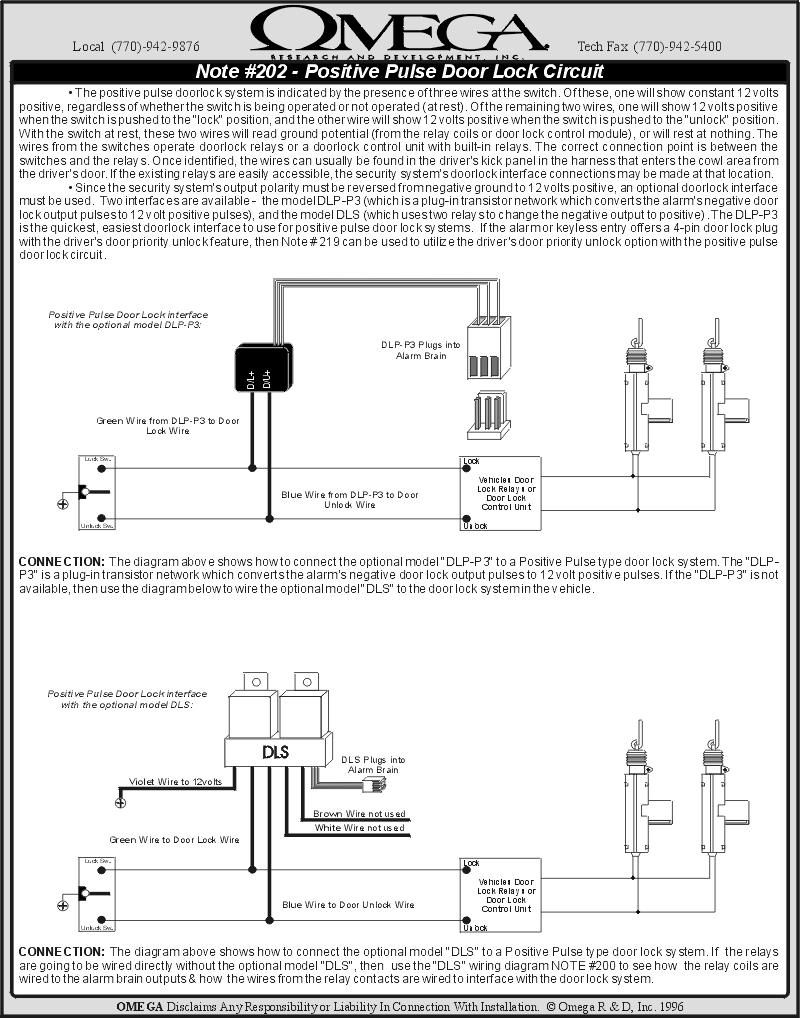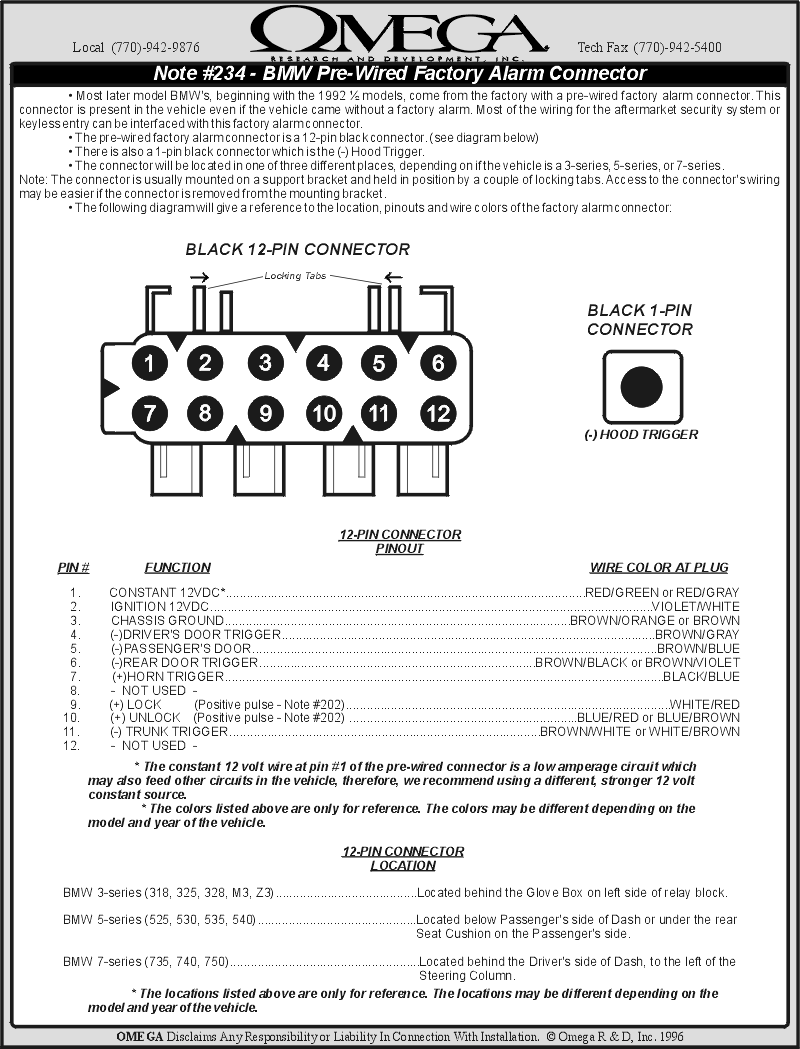Having just fitted a keyless entry system to my 5 series I thought I’d scribble it down so that other people can have an easier time doing the same thing!
Only use a multimeter for testing the wires, as these have a high impedance and won’t short anything out. DON’T use a test light (screwdriver with a croc clip and a bulb type) as this can mess up delicate circuitry.
Walkthrough
The System:
| |
Wires |
I wired in the pre-wired plug (that connects to the unit) first, before plugging it in. On the unit itself: · RED – Constant 12v · YELLOW – to switched 12v (comes on when ignition is on) I didn’t use the GREY or ORANGE wires, so cut any exposed wire off them and then taped the ends with insulation tape. | |||||||||||||||||||||||||||||||
The DLS Unit: | |||||||||||||||||||||||||||||||
The DLS unit is basically just 2 relays wired together – although for the OMEGA Here’s the wiring for those that need to know these things!
| |||||||||||||||||||||||||||||||
| LOCK / UNLOCK WIRES and Dead Lock System: | |||||||||||||||||||||||||||||||
Right then, this was a pain…coupled with the fact that the instruction booklet is not set out particularly well, having the worded description for the positive pulse wiring underneath the diagram for the negative pulse wiring….well, I blew one of the fuses by reading the words & following the diagram! Here’s the correct diagram (the 2 SPD relays are the 2 relays attached to the DLS!)
1. Open the boot (or ‘trunk’ if you prefer!) and undo the 4 plastic screws (each move a ¼ of a turn) on the trim on the boot lid itself. Unhook it over the rubber bump stops and pull it dow so you can see the lock mechanism and wires and bits. Make a note of where the solenoid is before you undo it, as the position is important for it to work properly. The solenoid is held in place by 2 brass-looking bolts (about 6 or 8 mm) – you should be able to see the near the black latch on the inside of the boot lid. By the key lock barrel (on the inside) you will see a bar with a 900 bend the end that sits in a plastic bush – this bar is attached to the solenoid and you need to push the bar out of the bush before the solenoid will come out. Undo the two nuts and remove the solenoid, leaving the wires plugged into it! It’s a bit of a fiddle, and is easier if you take the connecting bar out of the solenoid end as well. 2. With the solenoid out, you can open the top of the connecting plug to reveal the wires, which conveniently have round holes in to poke the meter into! By locking and unlocking (pull and push on the solenoid you’ve just got out) you can measure the voltages on the 5 pins exposed. Here’s what I found: RED/BLACK +12v all the time When DEADLOCKED with the key: · All 0v except WHITE/BLUE and RED/BLACK, which showed +12v The two additional relays (not the DLS) that I mentioned I didn’t use, are for if you want to protect the solenoids from damage that can occur if the door are deadlocked with the key, then tried to unlock by the remote. I didn’t do this, as the deadlocking had ben playing up and I didn’t want to use it anymore. If you don’t install these relays just remember when you’ve deadlocked the car! www.mypushcart.com can e-mail you the diagrams if you want to fit them. All the wires go back to the load of wires by the central locking control unit, and it will help matters if you can get some of the tape off to make it easier to separate the wires. This is how I wired it up (again, using Scotch-locks), and everything is working fine: DLS Wire Central Locking Wire
I did the testing the wires with the SL crimped on first, before connecting the wires…..just to be certain! Once everything was plugged in, I programmed the unit as per the instructions supplied. Finishing Off: The main unit itself has two mouting tabs with holes in. Just above where I connected the black GROUND wire, there is a threaded bolt hole – I found a bolt with the same thread and fastened the unit to the metal ‘wall’ securely. Again, it is not heavy at all and was held very firmly in place. The aerial wire. I pulled off the rubber/felt trim around the door frame and then fed the wire into it and pushed it back in place, so the wire ended up sealed in around the door frame – which gave quite good reception and was nicely out of the way. The system CAN operate the full closure system should your E34 have it (normally operated by holding the key in the lock or deadlock position). When the system is wired as described above, the full closure will not work. The reason for this ( I think) is that the boot (trunk) lock doesn’t operate the full closure when using the key – hence as the system is wired up off this set of wires, the full closure won’t work. If you can be bothered to try and figure out the lock/unlock wires from in the drivers or passenger doors, I guess it should work. I just decided that it would be considerably easier to use the boot lock wires, and also I quite like to leave he sunroof or windows slightly open in the summer when locking the car up. REALLY IMPORTANT>>>>>(my disclaimer!) What I have described I in these pages is EXACTLY what I discovered, tried and did, and I hope that it will help others. As we all know, new BMW bits are not cheap, and I was very worried about damaging solenoids or the central locking control unit. AS MUCH AS I HOPE THIS HELPS, IF YOU ARE UNSURE, CHECK WITH AN AUTO-ELECTRICIAN OR YOUR LOCAL ALARM DEALER AS I WOULDN’T WANT ANYONE BREAKING THINGS…..THIS IS AFTER ALL ONLY MY TAKE ON THINGS AND I DON’T DO THIS FOR A LIVING! | |||||||||||||||||||||||||||||||
| More Diagrams and info: | |||||||||||||||||||||||||||||||
Negative pulse door circuit & DSL
Positive pulse door circuit $ DSL (should be the right diagram for the BMW E34 – E32)
BMW Deadbold door lock circuit
BMW pre-wired factory alarm connector
Niels website: http://bmwe34.barracuda-central.org: Complete BMW Wiring-schematics online E34 cars and experience of his keyless entry. | |||||||||||||||||||||||||||||||
| More info on the keyless entry: | |||||||||||||||||||||||||||||||
All, Basically, when installing the system, you need to find a ground, a constant +12 volts, the lock wire and the unlock wire. If you want your locks to lock when you start your car and unlock when you shut it off, then you also need to find a +12 volts that comes on when the engine is running. I didn’t wire mine up to chirp the horn or flash the lights so I can’t help you there. It also pays to buy some low voltage tap-ins. I got a package of them from Radio Shack (#64-3053) for $1.69. They allow you to crimp your keyless entry wire onto the existing wire rather than cutting into the wire and soldering. You just squeeze them on with a plier. I’ve had good luck with them. Disclaimer: What follows is my take on things. I am not an engineer. Don’t hold me responsible if you blow a fuse or something. I’ve been as careful as possible, but verify what I’ve written by looking at your own Bentley manual or by talking to a pro or another person who’s done this. End of disclaimer. For ’92, ’93, and ’95 E34’s, the system installs under the back seat on the passenger side. Look for the 12-pin plug near the battery where the alarm module would plug in. The lock wire is white/red/yellow dots. The unlock is blue/red/yellow dots. The brown/orange wire is the ground, the red/gray wire is the constant +12 volts, and the violet/white wire is the one that is +12 volts when the car is running. 1994 E34’s are the same as above except the constant +12 volts is yellow wire on the alarm plug and the ground is brown. Sorry, but my Bentley’s doesn’t show which wire is the +12 volts when the car is running. For ’89 through ’91 E34’s, the system installs in the kick panel near the driver’s left foot. The lock wire is white/red/yellow dots. The unlock is blue/brown/yellow dots. You should be able to find a red wire for the constant +12 volts (here’s when a cheap multimeter is handy) and a small screw or something for the ground. I don’t know where to find the +12 volts that is hot only when the engine is running. The systems usually come with an LED that blinks to help you program the system and it blinks when the car is locked. I figured it may serve as a theft deterrent so I installed it in the plastic panel that is behind the right calf of a passenger sitting in the back seat on the opposite side of the car from the driver. I led the programming push button up behind the seat so it is behind the center armrest in the back seat, behind the cover that’s held up with Velcro, and even behind a small flap in the rubber sound-deadening material (my car doesn’t have the ski boot). I didn’t want to have to pull up the back seat to re-program the remotes or the system. I hope this helps. I’m not affiliated with Crimestopper or mypushcart.com or audio-etcetera.com. They were just the places I found on the web. There are a lot of good systems out there. Any of them should work as long as they do positive trigger (or you buy the relays and sockets and spend an extra 20 minutes wiring them in). Chris I. Double-locking (at least in my ’92 525i) is triggered by sending 12V to both the lock and unlock wires at the same time. All you need to do to enable double-locking is to solder a diode between those two wires. A cheap 1n5401 (available at Radio Shack) will do the job just fine. Solder the end of the diode with the solid line on it to the unlock wire, and the other end to the lock wire. The diode lets the voltage go to both wires when locking, and only the unlock wire when unlocking. It works by letting current flow through the diode from the lock wire to the unlock side during the lock process. Then it blocks the current to the lock wire when the unlock wire receives power. If it works backwards, then change the orientation of the diode. I have an alarm system that I bought from my local electronics wholesaler for about $60. It has most of the features of the big name alarms like code jumping, lock when the ignition is turned/unlock with key off, flashing lights, dual-level aux input, etc. The cool thing is that when the doors lock when I start my car, they don’t double-lock — there must be some logic in BMW brain somewhere that prevents the car from double-locking with the key is in the ignition. I hope this helps! Lito Reyes Here’s what I came up with. This should apply to ’92/’93/’95 E34’s. Like Chris said, if you explode your car or something, it’s your own damn fault 🙂 Please note that it’s entirely possible that my cause and effect is faulty. This is just what I traced down using a trusty test light. BTW, a test light like mine is handy for this kind of work. It’s one of the ones that looks like a screw driver with an alligator-clip wire emanating from the top. The real secret is that it eliminates those pesky short circuits because it just lights up if you are connecting opposite polarities. If you alternately hook the alligator clip to positive or negative, then you can probe for triggers because the bulb’s filament completes the circuit, and the trigger circuits don’t even pull enough current to light it up. This obviously isn’t a good idea where sensitive/high-impedance drivers are involved, i.e., fuel injector circuits in some cars or airbag wiring; in those cases, dig out the DMM.
In my case, I have a DEI keyless entry that came with all kinds of goodies I probably won’t use. I will mention some of the features I did use, and how. The great thing is that you don’t have to go anywhere except the plug under the rear seat. I’m pretty anal retentive and solder in everything instead of using taps; even so, the actual installation only took about 30 minutes. 1. Unlike some systems, this one supplies both positive and negative signals for lock/unlock. Unfortunately, this isn’t done with four separate wires, but with two. How? Each wire does double-duty, carrying the inverse of what the other does; for example, one wire is + lock, – unlock. The other is the opposite. This causes a bit of a problem when trying to do the double-lock action, since a single diode would still cause a short circuit between the + of the lock circuit and the – of the unlock (remember the other is always inverted). While DEI might have put in circuitry to eliminate this problem, I wasn’t taking chances, so I used two diodes to eliminate the possibility of + current going “back up” the unlock wire (see lower circuit in diagram). This might not be a bad idea even if your unit doesn’t reverse polarities, as the driver might still be sensitive to the onrush of current. Thus far, we have lock and double-lock (whoo-hooo). 2. …But we don’t have window/sunroof rollup. That’s because my keyless unit only supplies a pulse for lock, not a constant signal. This can be overcome (apparently) with add-on units that DEI supplies, but I don’t have no stinking time to wait around 😉 To add insult to injury, you can’t program this system to perform more than one channel function for the same key (separate channels are controlled by either separate buttons or unique combinations of two buttons pressed simultaneously). I reasoned that it wouldn’t be a *bad* use of the auxiliary button to perform the rollup feature. The auxiliary channel supplies a (-) signal as long as the button is pressed. As a side note, I also couldn’t just reprogram the auxiliary channel to the lock button, because the unit needs a “proper” lock signal to perform all the housekeeping it does (start blinking the LED, flash lights, honk horn, whatever). First the (-) signal was converted to (+) using a relay. Then a couple more diodes were utilized to merge the unlock and aux signals without screwing something up (upper diagram). BTW, I happened to have about 20 of these diodes around, I bought a pack of 25 a while back for another project 🙂 So now, you lock with the lock button, then press the aux button to roll up the windows, etc. I’m not sure what the current draw would do to an alarm system, though. It might think things are locked up and something is malevolently using electricity. 3. All the other DEI channels are (-) trigger, so I plugged them straight in to the dome light and parking light wires. I could have triggered the domes on unlock from the lock wire (remember that inversion thing?), but decided to use the “progressive unlock” channel. This is normally used to unlock the driver’s door on the first press of the unlock, and the rest of the doors on the second press. Now I can control whether the domes come on before the door is opened, by pressing the unlock a second time. 4. It’s not horny 🙂 Even though I’m sure the factory system has horn blip confirmation, I couldn’t find a wire from the rear of the car to perform this function. Even if it did, the horn relay only gets its constant + when the key is on (the horn button supplies the -). Actually, supplying the horn relay wire with a + positive signal when the car is off will honk the horn. I don’t know if this is by design or if the other side of the relay is grounding through the windings or filaments of other items in the same power circuit. Don’t laugh, the a/c relay on my Triumph is wired that way on purpose. Since I was putting the lower dash back together, I tapped into the relay wire and stowed a bundle under the carpet panel next to the console, for future use without taking everything apart. 5. I took advantage of the opportunity to wire in a few other indulgences. These are items that it would be foolish to post on the World Wide Web! Let’s just say that I made thieve’s lives a little harder.
| |||||||||||||||||||||||||||||||







